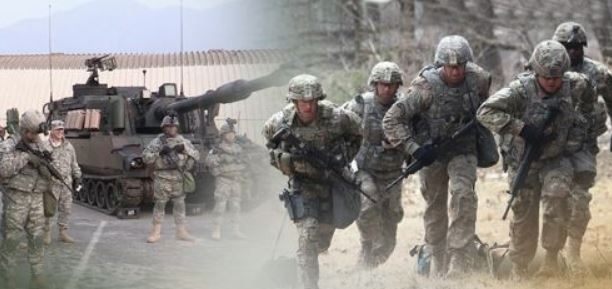History of US troops in Korea gains new attention amid talk of their future
By YonhapPublished : May 18, 2018 - 10:26
A resurgent debate over the future of US Forces Korea is bringing a renewed attention to the history of American troops here that now serve as a key guarantor of security for South Korea.
The US troop presence in Korea dates back to 1888, when a small military advisory group of interpreters set foot here after the 1882 Treaty of Amity and Commerce between the United States of America and Corea (Korea) initiated the countries' exchanges.
A larger US military contingent was dispatched to Korea in September 1945, when it undertook a postwar mission to disarm Japanese forces south of the 38th Parallel, a line drawn by the US and the then Soviet Union. Japan had colonized the peninsula since 1910.

American troops were withdrawn in 1949, but they returned the following year to defend the South under a United Nations mandate following the outbreak of the Korean War, the first major armed conflict of the Cold War.
Shortly after the North's invasion, South Korea's first president, Rhee Syng-man, handed "command authority" over all Korean forces to Gen. Douglas MacArthur, who headed the UN forces -- a move that entrenched America's military footprint in Korea.
Months after the war ended with an armistice in July 1953, Seoul and Washington signed the mutual defense treaty that now serves as a legal framework for the US troop presence in the South.
In the treaty, Rhee sought to include a clause requiring the US military to intervene "automatically and immediately" in a contingency, but he failed to do so in part because of Washington's lack of strategic interest in Korea, as evidenced by America's then defense perimeter that excluded the peninsula, historians said.
In November 1954, the allies drew up the "Agreed Minutes Relating to Continued Cooperation in Economic and Military Matters," a document that delineates Seoul's policy to retain its forces under the "operational control" of the US-led UN Command.
The minutes marked a change in the jargon from "command authority" to "operational control." Compared with the sweeping term of command authority, operational control represents more limited authority.
The UNC later handed the OPCON over to the South Korea-US Combined Forces Command, which was launched in November 1978, while limiting its role to maintaining the armistice. The peacetime OPCON returned to the South in 1994, while wartime OPCON still remains in the hands of the US military.
Seoul has been seeking to retake wartime OPCON from Washington in order to play a leading role in the allied military operations. But Pyongyang's provocations have led to repeated delays in the OPCON transfer.
Seoul currently believes that the "conditions-based" transfer could occur around 2023. The transfer is expected to affect the USFK role as the American troops will play a supporting role in wartime operations. (Yonhap)







![[Graphic News] More Koreans say they plan long-distance trips this year](http://res.heraldm.com/phpwas/restmb_idxmake.php?idx=644&simg=/content/image/2024/04/17/20240417050828_0.gif&u=)
![[KH Explains] Hyundai's full hybrid edge to pay off amid slow transition to pure EVs](http://res.heraldm.com/phpwas/restmb_idxmake.php?idx=644&simg=/content/image/2024/04/18/20240418050645_0.jpg&u=20240419100350)






![[From the Scene] Monks, Buddhists hail return of remains of Buddhas](http://res.heraldm.com/phpwas/restmb_idxmake.php?idx=652&simg=/content/image/2024/04/19/20240419050617_0.jpg&u=20240419175937)

![[KH Explains] Hyundai's full hybrid edge to pay off amid slow transition to pure EVs](http://res.heraldm.com/phpwas/restmb_idxmake.php?idx=652&simg=/content/image/2024/04/18/20240418050645_0.jpg&u=20240419100350)

![[Today’s K-pop] Illit drops debut single remix](http://res.heraldm.com/phpwas/restmb_idxmake.php?idx=642&simg=/content/image/2024/04/19/20240419050612_0.jpg&u=)